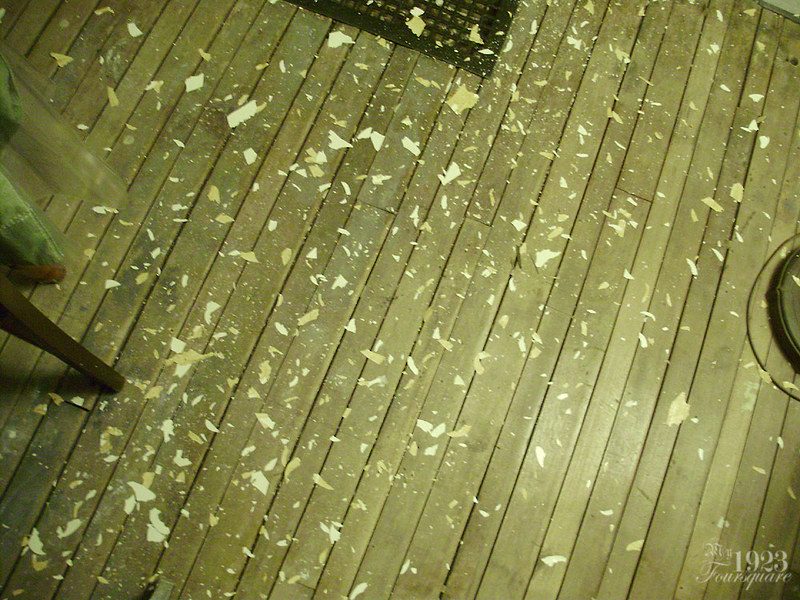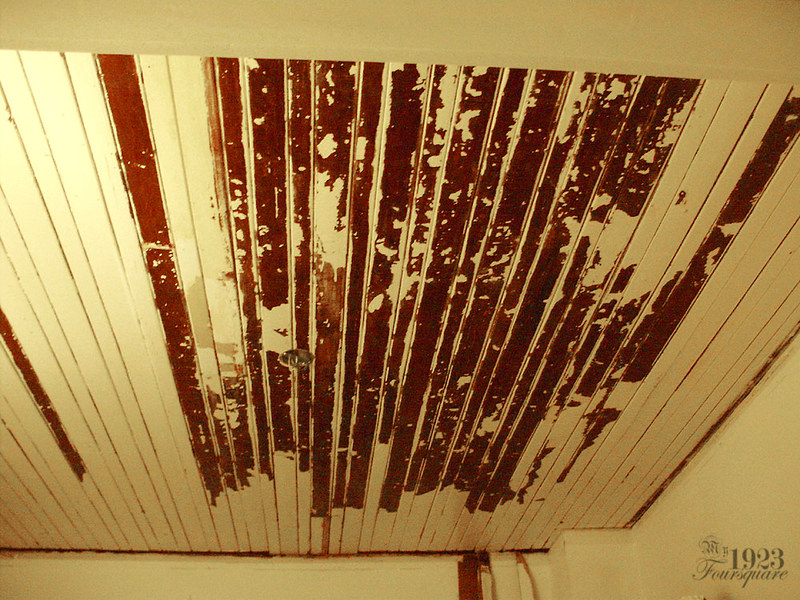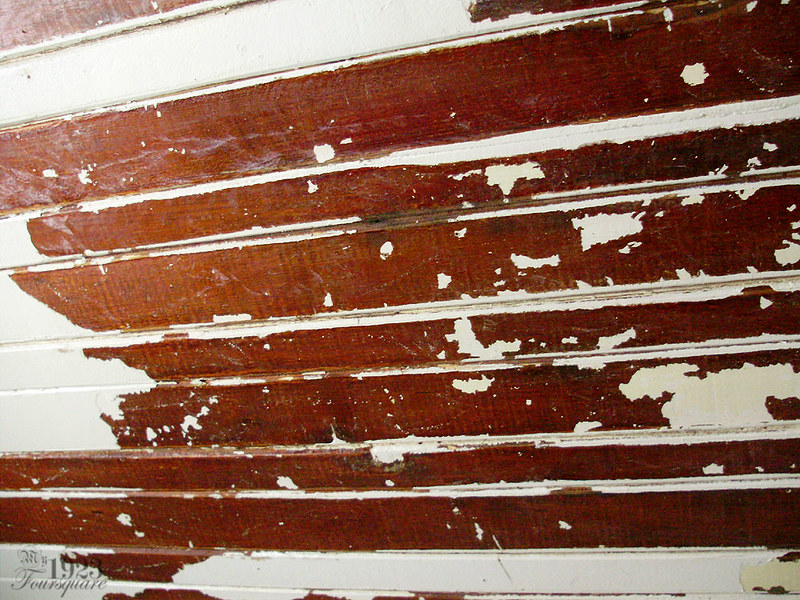A preview of things to come...

Unfortunately (or maybe fortunately? you be the judge) I ended up chipping off a big section of one board and then kept going.

This is the result of just half a minute of work. The thick layers of paint in the centre of the boards came off quite easily. This leaves just a bit of white at the edges where the paint had previously chipped and they had painted over it. The paint film separated right at the layer of shellac over the wood. As it turns out, the entire ceiling is actually stained and shellacked solid birch. In today's world (and today's prices) this would be about a 1000$ ceiling to put in. There's at least 500-600$ in wood, plus the added labour to have it stained and varnished. Back in the 1920s, however, it was probably just a bit more expensive than drywall, or possibly close to the same price, since drywall was still a very new product.


Here you can see a bit of an action shot (which was hard to photograph with my left hand) showing how the paint was coming off the boards.

Some of the first layer of oil paint was not coming off as easily, but at least the first 10 coats was chipping off pretty effortlessly.

This is probably and hour's worth of work. This was not fun, since you're working on a ladder with your neck bent.


The original shellac under the paint seems to have had some kind of reaction over the years and it now has sort of a swirly frosted look to it. Reminds me of frost on a window.

Here's a terrible photo.

By far the worst part of this whole job is just the paint chip management. I vacuumed the room about 3 or 4 times but it's basically an unending mess.

I think this is what I managed to scrape in one or two sessions (a few hours).

Yeah, I think that's what I did on the first night, and this was the next day (the bulk of the ceiling scraping was done between about Jan 2 to 6).





I also shot this terrible video for you guys. You might want to turn down your volume, as I had loud trance music on in the background as I was working.
As of today, 95% of the ceiling is paint free. I have a few edges left to do, then I can patch and putty the damaged bits. There's one big saw cut to putty, and several nail holes.
Yesterday I went to buy BIN (shellac based) primer and some white paint.
And yes I did briefly consider trying to save and refinish the original wood ceiling, but it would be an insane amount of work. All the cracks are still full of paint, the new patched-in boards don't quite match the original colour, and to actually get everything nice I'd have to chemical-strip, sand, and re-stain the entire ceiling. That's just NOT going to happen. It's too much work, and in the end, it wouldn't match anything else in the house. All the other ceilings and trim have already been painted-over decades ago. I'm just aiming to have a nice white tongue-and-groove ceiling instead of the drywall. I will also fix the ceiling in the kitchen, but not yet. There's no sense in trying to do it now because I need to remove the chimney in order to patch that corner hole. I will also need the cabinets to be out of there because they do sit right against the t-g ceiling and there's probably many extra coats of paint on the inside of the cabinets.
Speaking of the cabinets, I've actually determined that they must be original to the house. They kind of look more like 1940s or 50s cabinets, but the way they are built and how they were installed seems to prove that they were put in at the same time the house was built. They but-up against the ceiling, and they finish on the original tongue-and-groove paneling that went around the kitchen originally (more of the same wood). Additionally, when I removed the plumbing stack, the exposed cabinet side was unfinished white wash, which is the same wood that was used for the casings. Anyhow, more on that later.
Lastly, I'm including this photo to give you an idea of what a dark wood ceiling would look like. Many houses still have them, but a lot of people don't like the dark wood, so the survival rate for these is getting lower every year. The craze for DIY renos and constantly wanting to stay "on trend" with interior design is also not helping.


It's going to be beautiful. You're lucky to have such a beautiful wood underneath that paint.
ReplyDeleteYeah. It's too bad they were painted, but it's still better than drywall.
DeleteI've got two words for you: Heat Gun. :)
DeleteI have tried a heat gun (I own one) a few times for paint stripping, and I never ever like the results. Inevitably it seems to soften and gum-up one of the paint layers. There's also the chance of burning the wood, not to mention that the paint is probably lead, which you don't want to overheat. I guess I could try it in one spot, but I don't have high hopes, especially since there's shellac under there.
DeleteActually the shellac should make things much easier! It usually makes the paint pop right off as soon as you heat it up! The only problem is if there's paint in dings and gouges where the original finish is missing. You also need less heat than with paint on bare wood, even a hairdryer might just be enough. On the other hand I totally understand the downsides of varnished wood ceilings, I honestly wouldn't like them either.
DeleteI tried it on a small area and it's just not working. The heat instantly softens the shellac and basically turns it into masking tape or duct tape consistency. The top layers of paint don't seem as affected by the heat either, unless I apply a LOT of it.
DeleteSo I have dark stained and shellacked solid mahogany (at least that's what the prior owners say the wood trim is) but thank goodness one of the prior owners only painted trim in 3 rooms out of the 8. Just minor crappy painting issues to clean up in the majority of the rooms. But now I'm faced with the same decision...repaint the currently painted trim (latex over shellac, brilliant - not!) or strip and then stain/shellac. I'm not a fan of the glossy shellac look, but I also don't want to stain and do a satin varnish since that won't match the rest of the house.
ReplyDeleteThat is up to you. I would say that if you're going the strip and refinish route, I'd suggest pulling off the trim and doing it in pieces (which means marking and numbering everything). I know at least one or two old house owners who have stripped all their woodwork. It's a lot of messy work, but you know that the trim is nice solid clear wood, which is kind of a luxury item these days. Check out the before and after photos from Laurelhurst Craftsman: http://www.laurelhurstcraftsman.com/ Everything in their house had been painted. French doors, built-ins, coffered ceilings, you name it.
Delete